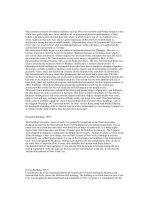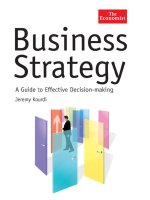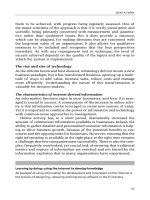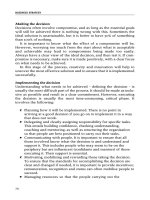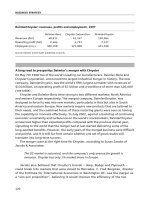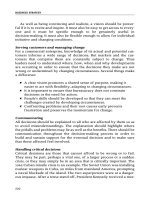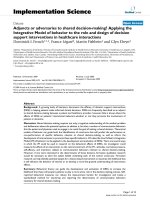What marketing factors affect to buying decision making of nhon hoangs products in vietnam
Bạn đang xem bản rút gọn của tài liệu. Xem và tải ngay bản đầy đủ của tài liệu tại đây (1.47 MB, 103 trang )
RESEARCH PROJECT
(BMBR5103)
WHAT MARKETING FACTORS AFFECT
TO BUYING DECISION MAKING OF
NHON HOANG PRODUCTS IN VIETNAM ?
STUDENT’S FULL NAME
: TRAN HOANG TRUC
STUDENT ID
: CGS00019593
INTAKE
: 09/2015
ADVISOR’S NAME & TITLE : DR. BUI PHI HUNG
FEBRUARY 2017
RESEARCH PROJECT
FEBRUARY, 2017
AVISOR’S ASSESMENT
………………………………………………………………………
………………………………………………………………………
………………………………………………………………………
………………………………………………………………………
………………………………………………………………………
………………………………………………………………………
………………………………………………………………………
………………………………………………………………………
………………………………………………………………………
………………………………………………………………………
………………………………………………………………………
………………………………………………………………………
………………………………………………………………………
………………………………………………………………………
………………………………………………………………………
………………………………………………………………………
………………………………………………………………………
………………………………………………………………………
………………………………………………………………………
………………………………………………………………………
………………………………………………………………………
………………………………………………………………………
………………………………………………………………………
………………………………………………………………………
………………………………………………………………………
Advisor’s signature
TRAN HOANG TRUC
Page II
RESEARCH PROJECT
FEBRUARY, 2017
ACKNOWLEDGEMENT
I would like to express my grateful to all persons who gave me the possibility to
complete this study.
Through the essays requires reasoning and analysis from reality, I have been trained
how to deduce the problems and know how to apply literature reviews into work.
For me, MBA program is not just simply as a normal course, it represents for my
effort and attempt, where I was exposed to extensive knowledge of many authors.
First and foremost, I want to give big thanks to Open University, HUTECH
University and the lectures in MBA OUM program, who have imparted knowledge
and valuable experiences to us.
In particular, I would like to express my sincere gratitude to Dr. Bui Phi Hung, who
has spent much time and effort to help me complete the dissertation.
Simultaneously, I also want to thank my classmates for their support for this thesis
in particular and the whole program in general.
I also want to give my big thanks to Nhon Hoang company, partners and customers
of Nhon Hoang company who have supported me to complete the data collection
for my research project.
Once again, thank everyone for having accompanied me throughout this journey.
Ho Chi Minh, 2017
TRAN HOANG TRUC
Page III
RESEARCH PROJECT
FEBRUARY, 2017
EXECUTIVE SUMMARY
The main objective of this research is to review the present marketing mix affects to
the customer decision making. This research provides an idea to the marketers and
can be used as tools to assist them in pursuing their marketing objectives.
The research was conducted from November 2016 to Feb 2017. The targeted
customers participating in the research are the customers of Nhon Hoang chosen
randomly. After reviewing the literature, Marketing Mix model of Kotler, P., &
Armstrong, G. (2009) are applied as the conceptual framework to measure what
marketing factors affect to buying decision making of Nhon Hoang products in
Vietnam. The study only uses quantitative approach.
The finding of this study also show which dimensions and items are important to
enhance sales figures of Nhon Hoang products. In details, through five stages of the
process, all of marketing factors have effect to customers’ buying decision making.
Even though there are some limitations in this research, this study might help Nhon
Hoang company understand their customer buying behavior. Based on the finding
and suggestion, managers can know which one they need to change for improving
and developing more in the future.
TRAN HOANG TRUC
Page IV
RESEARCH PROJECT
FEBRUARY, 2017
TABLE OF CONTENTS
CHAPTER 1 : INTRODUCTION ............................................................................. 1
1.1
Introduction ................................................................................................... 1
1.2
Background ................................................................................................... 1
1.3
Company introduction.................................................................................... 2
1.4
Product introduction....................................................................................... 3
1.5
Research Question ......................................................................................... 4
1.6
Research Objective ........................................................................................ 4
1.7
Research scope .............................................................................................. 5
1.8
Thesis outline................................................................................................. 5
1.9
Conclusion ..................................................................................................... 6
CHAPTER 2 : LITERATURE REVIEW.................................................................. 7
2.1
Marketing mix ............................................................................................... 7
2.1.1
Product ................................................................................................ 8
2.1.2
Price .................................................................................................. 11
2.1.3
Place .................................................................................................. 13
2.1.4
Promotion .......................................................................................... 19
2.2
Consumer behavior ...................................................................................... 22
2.3
Consumer decision making process.............................................................. 25
2.4
Marketing strategy and consumer behavior .................................................. 25
2.5
The effect of the elements of marketing mix on consumer behavior ............. 27
2.5.1
Product – Consumer behavior ............................................................ 27
2.5.2
Price – Consumer behavior ................................................................ 27
TRAN HOANG TRUC
Page V
RESEARCH PROJECT
FEBRUARY, 2017
2.5.3
Place – Consumer behavior ................................................................ 28
2.5.4
Promotion – Consumer behavior ........................................................ 28
2.6
Conclusion ................................................................................................... 29
CHAPTER 3 : RESEARCH METHODDOLOGY ................................................. 30
3.1
Introduction ................................................................................................. 30
3.2
Research progress ........................................................................................ 30
3.3
The Sampling Method .................................................................................. 33
3.3.1
Sampling technique .................................................................................. 33
3.3.2
Sample size .............................................................................................. 34
3.4
Questionnaire ............................................................................................... 34
3.5
Reliability .................................................................................................... 36
3.6
Ethical consideration .................................................................................... 37
3.7
Conclusion ................................................................................................... 38
CHAPTER 4 : FINDING ......................................................................................... 39
4.1
Descriptive statistics .................................................................................... 39
4.2
Reliability test – Verify Cronbach’s Anpha .................................................. 46
4.3
Exploratory Factor Analysis (EFA) .............................................................. 51
CHAPTER 5 : DISCUSSION................................................................................... 57
5.1
Product ........................................................................................................ 57
5.2
Price ............................................................................................................ 58
5.3
Place ............................................................................................................ 60
5.4
Promotion .................................................................................................... 62
5.5
Official model .............................................................................................. 63
CHAPTER 6 : CONCLUSION AND RECOMMENDATIONS ............................ 65
TRAN HOANG TRUC
Page VI
RESEARCH PROJECT
FEBRUARY, 2017
6.1
Conclusion ................................................................................................... 65
6.2
Recommendations ........................................................................................ 65
6.2.1
Product ..................................................................................................... 65
6.2.2
Price ......................................................................................................... 66
6.2.3
Place ........................................................................................................ 66
6.2.4
Promotion................................................................................................. 66
6.3
Limitation .................................................................................................... 66
6.4
Recommendation for further research .......................................................... 67
REFERENCES ............................................................................................................ i
APPENDICES........................................................................................................... vii
TRAN HOANG TRUC
Page VII
RESEARCH PROJECT
FEBRUARY, 2017
LIST OF TABLES
Table 4.1: The agreement degree of factors affect to buying decision making of
Nhon Hoang products ........................................................................................... 41
Table 4.2: The statistics of product factor’s respondents ....................................... 43
Table 4.3: The statistics of price factor’s respondents ........................................... 44
Table 4.4: The statistics of place factor’s respondents .......................................... 44
Table 4.5: The statistics of promotion factor’s respondents ................................... 45
Table 4.6: The statistics of all factors’ respondents ................................................ 45
Table 4.7: Verify Cronbach’s Alpla of Product Factor ........................................... 46
Table 4.8: Verify Cronbach’s Alpla of PriceFactor ................................................ 47
Table 4.9: Verify Cronbach’s Alpla of Place Factor .............................................. 48
Table 4.10: Verify Cronbach’s Alpla of Place Factor............................................. 49
Table 4.11: Verify Cronbach’s Alpla of Promotion Factor..................................... 50
Table 4.12: Verify Cronbach’s Alpla of all Factors................................................ 51
Table 4.13: KMO and Bartlett’s test ..................................................................... 52
Table 4.14: The total variance explained of independent variables ........................ 52
Table 4.15: The first EFA analysis Component Matrix .......................................... 54
Table 4.16: The final EFA analysis - Rotated Component Matrix .......................... 55
Table 5.1: Response per statement for the Product factor ....................................... 57
Table 5.2: Response per statement for the Price factor ........................................... 58
TRAN HOANG TRUC
Page VIII
RESEARCH PROJECT
FEBRUARY, 2017
Table 5.3: Response per statement for the Place factor .......................................... 60
Table 5.4: Response per statement for the Promotion factor .................................. 62
TRAN HOANG TRUC
Page IX
RESEARCH PROJECT
FEBRUARY, 2017
LIST OF FIGURES
Figure 2.1: The elements of marketing mix ............................................................. 7
Figure 2.2: Channels for consumer products .......................................................... 15
Figure 2.3: Overall model of consumer behavior .................................................. 24
Figure 2.4: Consumer decision process .................................................................. 25
Figure 2.5: Dissertation model ............................................................................... 29
Figure 3.1: Research progress ................................................................................ 32
Figure 4.1: Gender ................................................................................................. 39
Figure 4.2: Gender ................................................................................................. 40
Figure 4.3: Income ................................................................................................ 41
Figure 5.1: Response per statement for the Product factor ..................................... 58
Figure 5.2: Response per statement for the Price factor ......................................... 59
Figure 5.3: Response per statement for the Place factor ......................................... 61
Figure 5.4: Response per statement for the Promotion factor ................................. 63
Figure 5.5: Official model ..................................................................................... 64
TRAN HOANG TRUC
Page X
RESEARCH PROJECT
FEBRUARY, 2017
CHAPTER 1 : INTRODUCTION
1.1 Introduction
A marketing strategy can be described as the pattern of current and future objectives,
resource deployments and interactions of an organization with markets, competitors, as
well as other environmental factors (Hollensen, 2003). The reason being that the
marketing strategy guides an organization on how to satisfy the needs and wants of its
target market. Satisfied customers are motivated to become loyal customers, thereby
ensuring repeat purchases resulting in higher profits (Machado & Cassim, 2002).
This chapter outlines the case for this research project. In particular, it discusses the
significance of marketing factors to customer’s buying decision making and,
subsequently, introduce the research; discuss the background and scope of the
research, present the structure for this dissertation. It will discuss the aims and the
specific objectives of the research, and a brief description of the approach taken to
achieve these objectives.
1.2 Background
Vietnam is deeper integration into the global economy, especially via such a
comprehensive free trade agreement. The establishment of the ASEAN Economic
Community, the signing of a number of free trade agreements in 2015 and the Trans
Pacific Partnership on 4 February 2016, Vietnam has undergone internal reforms such
as Decree No. 60/2015/ND-CP and the new laws on investment and enterprise, brings
various opportunities and challenges (Nguyen Duc Thanh et al., 2015).
The increase in international companies and global corporations make a change in
Vietnam market. More and more competitors enter the market with new technologies
and strong capital. The customers also require products with high quality, low price
and safety. In recent years, enterprises increasingly establish their marketing strategy
TRAN HOANG TRUC
Page 1
RESEARCH PROJECT
FEBRUARY, 2017
based on the consumer (He, H. & Li, Y., 2010).
Vietnam consumer market trend in 2016 is the rise in purchase power in 2016. Over
the past 10 years Vietnam has experienced rapid economic development. The number
of high income households earning over US$500 per month per household, has risen
from 1.8 million to over 4 million (Cimigo, 2016). Advertising has grown fast, the
increase in numbers of brands and the rise of domestic companies (especially in foods,
beverages and healthcare) embracing the consumer economy in Vietnam. Advertising
in Vietnam expenditure grew nearly 600% in 10 years (Cimigo, 2016).
Therefore, traditional Vietnamese companies need to change the way in their business,
especially marketing strategies as well as marketing research. Marketers have
acknowledged the importance of consumer attitudes and discussed marketing strategy
with consumer behavior (Vinson, et al., 1977). They should do marketing research
which is to gather data about customers in the present markets to understand what
customers really want and to monitor trends in the markets, as well as to conduct
research to help decision maker choose the appropriate strategies.
1.3 Company introduction
Nhon Hoang is one of traditional food companies at Cai Be Village in Tien Giang
Province where produces the most quantity of these cakes. The government presented
Cai Be village a title: “Cai Be coconut paper trade village”.
Company has established since 1992. Nhon Hoang specializes in producing coconut
paper. In 2016, company has 70 employees, produces about 2000kg output per day.
Nhon Hoang produces three kinds of cakes with different flavors:
Milk coconut paper
Durian coconut paper
Sesame coconut paper
TRAN HOANG TRUC
Page 2
RESEARCH PROJECT
FEBRUARY, 2017
In Tet holiday, Nhon Hoang produces more two kinds of cakes:
Grilled glutinous rice paper
Grilled coconut paper
There are many kinds of packages with different weight and size: small size 10.5
inches (260g), medium size 11.5 inches (350g) and large size 12.5 inches (450g &
500g).
Nhon Hoang products are distributed in the South of Vietnam and some provinces in
the Middle of Vietnam. Collaborators of Nhon Hoang are mostly the rest stop stations
and stores along the highway: Satra-Phuong Trang, Minh Phat rest stop station, Tam
Ri chain restaurants, Hung Thanh company, Lothamilk company,… Coaches pass
there and take a rest about 20 minutes. Passengers take a break, eat and buy something
there. One station welcomes thousands of passengers every day. They consume a large
number of products.
In 2014, Nhon Hoang got gold medal “Vietnam Trust Food 2014” and the title “Safe
food for health of community”.
1.4 Product introduction
Traditional food systems of indigenous peoples have been recognized as important
resources, and documentation of these in different parts of the world is progressing
(Martina A. Schmid, 2005). Milk coconut paper is a traditional food of Western
Vietnam. Travelers often buy this cake as a gift when they pass this area.
The origin of this cake is from grilled glutinous rice paper cake. The custom in the
South of Vietnam is every household makes grilled coconut paper cakes and grill them
to worship their ancestors in Tet holiday over 100 years ago. Besides that, they also
want to eat instantly, so milk coconut paper was created. Now a day, local people
divide this cake into three main kinds of cakes:
+
Grilled glutinous rice paper: made from glutinous rice, coconut milk and
TRAN HOANG TRUC
Page 3
RESEARCH PROJECT
FEBRUARY, 2017
sugar.
+
Grilled coconut paper: made from manioc, coconut milk and sugar.
+
Milk coconut paper: made from manioc, coconut milk, sugar, malt and
sweetened milk (some kinds of cake are added durian or sesame).
1.5 Research Question
The research question for this dissertation was “What marketing factors affect to
buying decision making of Nhon Hoang products?” This question will allow the
researcher to explore which factor influence to customer’s buying decision of Nhon
Hoang products and how marketing factors affect to Nhon Hoang’s customer buying
decision making. There are four marketing factors: Product, Price, Place, Promotion.
The following questions are derived from the main research question:
How does the factor Product affect to buying decision making of Nhon Hoang
products?
How does the factor Price affect to buying decision making of Nhon Hoang products?
How does the factor Place affect to buying decision making of Nhon Hoang products?
How does the factor Promotion affect to buying decision making of Nhon Hoang
products?
1.6 Research Objective
The main objective of the research is to determine the effect of marketing factors
consist of product, price, place, promotion on customer’s buying decision making of
Nhon Hoang products. Therefore, the results will help the company increase customers
through marketing strategies.
TRAN HOANG TRUC
Page 4
RESEARCH PROJECT
FEBRUARY, 2017
This research aims to:
Find out the marketing factors that affect to buying decision making of Nhon Hoang
products.
Analyze the key marketing factors which impact to customer’s decision making of
Nhon Hoang products.
Enhance the ability of Nhon Hoang company to achieve excellent standard in their
business.
1.7 Research scope
This research will examine the link between marketing factors and buying decision
making of Nhon Hoang products. The research will be made from October 2016 to
December 2016 at Satra-Phuong Trang, Long Thanh rest stop station, and some stores
along highway 1A in the Western of Vietnam.
Due to time restraints, the sample will be limited to 300 customers. This may mean
that the results cannot be generalized to the whole population.
1.8 Thesis outline
This research includes five chapters which are showed bellows:
Chapter 1: Introduction – Starting general introduction of Nhon Hoang company and
their products. It has also discussed the objectives, scope and method of this study.
Chapter 2: Literature Review – Reviewing literature related concepts, marketing
factors effect to buying decision making of Nhon Hoang products and then drawing
the research model.
Chapter 3: Methodology – Giving the detail of research data, quantitative method used
in this study, data collection and data analysis.
Chapter 4: Finding – Giving the result obtained of primary data collection from the
TRAN HOANG TRUC
Page 5
RESEARCH PROJECT
FEBRUARY, 2017
survey.
Chapter 5: Discussion of findings – Analysis of the data and the empirical result of this
study. The empirical results focused on the importance of the research variable.
Chapter 6: Conclusion and Recommendations – Discussing the research finding and
suggesting the recommendations for raising their marketing strategies.
1.9 Conclusion
Marketers need to ensure a combination of the identified factors of marketing mix
need to change as the business environment changes (Du Plessis & Rousseau, 2003).
This is important because it will make an offering acceptable to the target market
(Adcock et al., 2001).
This chapter has introduced the research and outlined the aims and relevance of it. It
has discussed the scope of the research and created a research question that can be
investigated. The next chapter will present existing literature surrounding the question
“What marketing factors affect to buying decision making of Nhon Hoang products?”
This will give background knowledge for the topic and will be informative about what
has previously been investigated.
TRAN HOANG TRUC
Page 6
RESEARCH PROJECT
FEBRUARY, 2017
CHAPTER 2 : LITERATURE REVIEW
This chapter will focus on the consumer’s
consume ’s buying decision making process, the
different components of the marketing mix and the effect of marketing on consumer
behavior.
2.1
Marketing mix
When an organization ha
has made a decision about its overall marketing strategy, it can
start to plan the elements of the marketing mix which it needs to use to attract the
target market for its products or services. The marketing mix is a set of elements that
an organization can control
ontrol to produce the response it requires from the target market.
The marketing mix is composed of all the activities which an organization can perform
2009
to influence the demand for its offerings (Kotler & Armstrong, 2009).
The organization designs an integrated
integrated marketing mix made up of factors under its
.1 represents the elements of marketing mix: Product, Price, Place,
control. Figure 2.1
Promotion. For the purposes of this study, each of the elements of the marketing mix
will be discussed in more detail below.
belo
Marketing Mix - 4 P's
PRODUCT
•Variety
•Features
•Brand name
•Packaging
•Design
•Quality
•Services
PRICE
••List Price
••Discounts
••Allowances
••Payment period
••Credit terms
PLACE
•Channels
•Coverage
•Assortments
•Locations
•Inventory
•Transportation
•Logistics
PROMOTION
•Advertising
Advertising
•Personal
Personal selling
•Sales
Sales promotion
•Direct
Direct marketing
•Public
Public relations
Figure 2.1: The elements of marketing mix (Kotler, P., & Armstrong, G., 2009)
TRAN HOANG TRUC
Page 7
RESEARCH PROJECT
FEBRUARY, 2017
2.1.1 Product
McCarthy and Perreault (2003) describe a product to be a good or service aimed at a
specific target market. Blackwell et al. (2006) state that product includes goods and
services with tangible and intangible attributes. They further mention that products
may be bought for different reasons ranging from satisfying a basic need to indulging
in something that feels good.
Palmer (2000) states that the elements of a product that can be controlled by a
marketer include variety, features, brand name, packaging, design, quality and
services.
2.1.1.1 Variety
Product variety is referring to the different number of products that is included in one
product line. Strong competition in the market place and demanding customers have
contributed to the increase of product variety in many product categories. An increase
in product variety does not guarantee profit increase. Since product variety is
influenced by the changing requirements of consumers, the quality of the introduced
product will also vary. In the modern business world, it is challenging for
organizations to manage product variety. However, those organizations which are able
to match their supply chain structure with the type of product variety that they have to
offer to the target market, outperform those that are unable to match their supply chain
structure (Davila & Wouters, 2007).
The introduction of new products is essential, because it improves the welfare of
consumers. Some effects of the introduction of new products are that consumers will
have surplus associated with the additional variety provided by new products.
Competition will be strong among existing products due to the introduction of new
products. If an organization that introduced a new product into the market has no
existing products in the market, it is likely to lead to the reduction of prices for all
competing products which will benefit consumers (Hausman & Leonard, 2002).
TRAN HOANG TRUC
Page 8
RESEARCH PROJECT
FEBRUARY, 2017
2.1.1.2 Features
Product offerings have different features that can be grouped into three levels namely,
the core, the expected and augmented levels. The product offering consists of elements
that make an offering to be enjoyed by the consumer. It is essential for marketers to
pay attention to the elements that make up a product to ensure that it meets customers’
expectations and leads to repeat purchases (George, 2004). Hoffman et al. (2005)
stipulate that products consist of a bundle of benefits that are develop through product
decisions and a new product development process.
The features and value of a product are the results of compromises between varying
requests. The requests can come from the producing organizations due to interaction
with customers, the technological development functions of many directly or indirectly
related organizations, and different roles of independent intermediaries, such as
distributors (Hakansson & Waluszewski, 2005).
2.1.1.3 Brand name
George (2004) describes a brand as a product or service made distinctive by its
positioning relative to the competition, and by its personality in the context of the
target market. The brand names of products are sometimes regarded to be more
valuable than the offerings they present. Brand names furthermore encourage
consumers to purchase offerings because they provide them with the benefits which
they need. Du Plessis et al. (2005) state that brand distinguishes competing products in
the market. Organizations use brands to differentiate their products from those of their
competitors. According to Cravens and Piercy (2006), the following functions of
brands can exist for consumers:
The quick identification of products reduces consumers’ search costs.
Providing assurance of quality which reduces consumers’ perceived risk.
Reduce social and psychological risks that are associated with using the wrong
TRAN HOANG TRUC
Page 9
RESEARCH PROJECT
FEBRUARY, 2017
product.
2.1.1.4 Packaging
Marketers develop packaging for an offering in a manner that it will perform functions
such as promotional, protective and user-convenience (Hoffman et al., 2005).
Packaging decisions need to consider the efficiency of the production process,
consumer acceptance and the need to protect while it is in storage and transit (Bradi,
Coyle & Novack, 2006).
2.1.1.5 Design
Factors such as climate and geography are considered by organizations when they
design their offerings. Marketers need to ensure that the ingredients or features of their
offerings are not violating legal requirements, the religion or the social customs of
customers (Hoffman et al., 2005). The design of a product has an influence on the
appearance of a product, increases the value of a product and also attracts non-users
(Vranesevic, T., Vignali, C. & Vignali, D, 2004).
2.1.1.6 Quality
An organization that produces products, considers a question of how much quality to
build into the product. In a product, quality constitutes the ability of a product to
deliver the functional requirements expected of it. Durability is the main dimension of
quality. Products of high quality are usually made from better materials that involve
expensive processing. The price the target market is prepared to pay has an influence
on the level of quality of the product (Dibb et al., 2001). When customers can realize
after purchase that the products they bought are of low quality, they are more likely
not to purchase them again in the future (Kurtz & Boone, 2006).
2.1.1.7 Services
The product related services and product intangibles that are commonly used by
organizations are guarantees, repairs or replacements and credit. Customers consider
TRAN HOANG TRUC
Page 10
RESEARCH PROJECT
FEBRUARY, 2017
the type of guarantee provided by an organization before they make a purchase. This is
particularly relevant when customers purchase expensive and technically complex
goods. Marketers use guarantees as tools to give their products a competitive
advantage. They also use parts replacements and repair services to attract customers.
2.1.2 Price
Price is the amount of money that a consumer must pay to obtain a product or service
(Peter & Olson, 2005). An organization that is selling its product at a high price may
not attain its sales volume targets. If an organization sets the price of a product at a low
level, volume targets may be attained, but no profit will be earned (Palmer, 2000).
Peter and Olson (2005, p.464) specify that consumers need to ensure that they get
value out of what they purchase. Price must interact with other elements of the
marketing mix to ensure that an offering is correctly price. Price reflects the quality
and value of an offering (George, 2004).
Sternberg (2004) stated that the relationship between price and value is illustrated by
the statement that says “we can no longer look at manu prices or average checks to
determine value”. When customers view their dining experience as worth the price
paid, then the meal will be seen as having value, regardless of the portion size of the
individual’s fillet. Below is a discussion of the pricing policies of organizations.
2.1.2.1 List price
A list price is a price that a final consumer or user is requested to pay for a product
(McCarthy & Perreault, 2003). A list price is the setting of one price without
differentiating it according to the different segments of the market that an organization
might target (Avlonitis & Indounas, 2005).
TRAN HOANG TRUC
Page 11
RESEARCH PROJECT
FEBRUARY, 2017
2.1.2.2 Discounts
McCarthy and Perreault (2003) describle discounts as reductions given to buyers by
sellers from list prices and these buyers either give up some marketing function or
provide the function themselves. A discount is an advertisement in which there is price
reduction that is not involving a coupon or voucher (George, 2004). The magnitude of
cash discount reflects information about product quality. Organizations that produce
low quality products are more likely to offer large discounts to induce consumers to
pay before verifying product quality, thereby transferring risk to the consumer.
Organizations that produce high quality products are very confident that their product
will meet customer requirements and will not offer high discounts to consumers (Pike,
Cheng, Cravens & Lamminmaki, 2005).
Marketers offer different types of discounts such as cash, trade and quantity discounts
(Kurtz & Boone, 2006). A cash discount is received by buyers when they pay in cash
or without delay (Hoffman et al., 2005). Trade discounts are paid to channel members
for performing marketing functions (Kurtz & Boone, 2006). Finally, quantity
discounts are offered to customers to encourage them to purchase in large quantities.
This kind of discount allows the seller to obtain a larger share of a buyer’s business
(McCarthy & Perreault, 2003).
2.1.2.3 Allowances
Allowance refers to the promotional money that is paid by the manufacturers to the
retailers in return for an agreement to feature the manufacturer’s products in a specific
manner (Hollensen, 2003). Kurtz and Boone (2006) argue that allowances are similar
to discounts, because they specify deductions from list price. The man categories of
allowances are trade-ins and promotional allowances. Trade-ins are often used when
selling durable goods such as cars. In the case of the trade-in method, the product’s
basic list price remains unaltered, but the seller accepts the used product together with
less money from the customer. Promotional allowances involve the reduction of prices
as an attempt to integrate promotional strategies within distribution channels.
TRAN HOANG TRUC
Page 12
RESEARCH PROJECT
FEBRUARY, 2017
2.1.2.4 Payment period
In today’s competitive business world, organizations are offering their customers a
specified period to settle their accounts (Sarker, Jamal & Wang, 2000). Interest is not
charged o the outstanding amount if it is paid within a stipulated time period.
However, if the amount owed to the organization is not paid in full by the end of the
stipulated period, then interest is charged on the outstanding amount (Teng, Chang,
Chern & Chan, 2007).
An organization that has many customers is more likely to offer credit. This can also
apply to the length of payment period granted, because of the larger spread of
customers that make it hard for strong relationships to be formed between two parties.
Under these conditions sellers may build relationships and enhance the popularity for
quality by extending the payment period (Pike et al., 2005).
2.1.2.5 Credit terms
An organization can provide credit service to customers. Marketers of expensive
products such as furniture and technology products can offer credit to enable a large
number of customers to purchase these products and enlarge the market for their
products (Dibb et al., 2001). Credit terms can be seen as a solution to problems
concerning product quality and customer creditworthiness. This is relevant for high
technology products that take long to verify. The credit period is also seen as a product
verification period (Pike et al., 2005).
2.1.3 Place
Popovic (2005) refers to place as all marketing channels, location and activities such
as readiness to make the product accessible to the target market. Place includes
communication with customers that depends on the time difference of geographical
areas and the delivery of free samples. Hakasson and Waluszeski (2005) stipulate that
TRAN HOANG TRUC
Page 13
RESEARCH PROJECT
FEBRUARY, 2017
the place is an “issue that is equal with handling and distribution channel that brings
the given product to its potential users, and the main task is to link an existing supply
with an existing demand”.
Place can also refer to the accessibility of a service by potential customers. The
inseparability of services complicates the passing of the benefits of service. The
inseparability of a service implies that one person cannot be able to produce a service
at one place and make it available to customers in another place. A service cannot be
manufactured in a low cost area and sold where demand is high (Palmer, 2000).
Place is an important element of the marketing strategy. Place and the other three Ps of
the marketing mix, namely product, price and promotion need to be developed
together to meet the need and wants of the target market (Hakansson & Waluszeski,
2005). Competitors can sell the same product, using the same promotional methods
and at the same price to compete other suppliers in the market place (Hoffman et el.,
2005).
2.1.3.1 Channels
Organizations need to carefully choose their distribution channels and evaluate their
sales and profit levels, performance records, other carried products, clientele and
availability of a distribution channel when needed. The reason for this being to ensure
that the distribution channel does not prioritize distribution of the competing products.
The other elements of the distribution channel that need examination include
organizational objectives and resources, market characteristics, buying behavior,
product attributes and environmental forces to evaluate the strengths and weaknesses
of an organization (Machado & Cassim, 2002).
Distribution channels serve many functions such as creating utility, facilitating
exchange efficiencies, alleviating discrepancies, standardizing transactions and
providing customer service (Dibb et al., 2001). A distribution channel can be long or
short, single or multiple, direct or indirect. There are different distribution channels for
TRAN HOANG TRUC
Page 14
RESEARCH PROJECT
FEBRUARY, 2017
different products because the products that are distributed vary according to size and
price (Adcock et al., 2001). A distribution channel that is simple and short is a direct
channel. In a direct channel there are no intermediaries between the producer and its
customers (Kurtz & Boone, 2006).
In indirect channels there are many intermediaries that perform different functions for
an offering to reach the target market. Due to the length of the distribution channel, it
is not easy to cope with the problem of having products out of stock. It is important to
note that the longer the distribution channel, the more difficult it is to cope with
differences in consumer demand (Adcock et at., 2001).
Figure 2.2: Channels for consumer products
2.1.3.2 Coverage
Coverage refers to the geographical areas of a country such as cities and major towns,
or the number of retail outlets. Regardless of the market coverage measure used, an
organization needs to create a distribution network that can include dealers,
distributions and retailers to meet its coverage goals (Hollensen, 2005). It is important
for an organization to have access to suitable distribution channels, as inaccessibility
TRAN HOANG TRUC
Page 15

